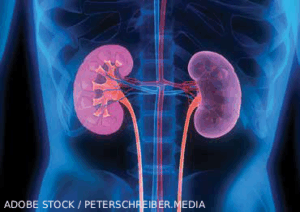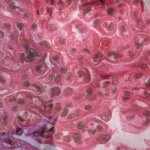 DESTIN, FLORIDA—Management of lupus nephritis is an evolving area with several new therapies introduced in recent years. During the annual Clinical Congress of Rheumatology East in May, Michelle Petri, MD, MPH, MACR, gave a presentation titled It Is Time to Rethink Lupus Nephritis, in which she shared her personal treatment perspectives.
DESTIN, FLORIDA—Management of lupus nephritis is an evolving area with several new therapies introduced in recent years. During the annual Clinical Congress of Rheumatology East in May, Michelle Petri, MD, MPH, MACR, gave a presentation titled It Is Time to Rethink Lupus Nephritis, in which she shared her personal treatment perspectives.
Dr. Petri is a professor of medicine in the Division of Rheumatology at Johns Hopkins University, Baltimore, and the director of the Hopkins Lupus Center. She kicked off the talk by joking, “There are very few easy things in lupus. And I’m going to take away one of them: lupus nephritis.”
Proteinuria Misconceptions
Dr. Petri highlighted a common misconception regarding a proteinuria threshold for kidney biopsy to evaluate for lupus nephritis. “We think you do not have to biopsy until the proteinuria hits 500 mg,” Dr. Petri said. “And in clinical trials, we call it a ‘complete renal response’ if we get the proteinuria below 500 mg. [But] there’s nothing normal about having 500 mg of proteinuria.”
In the general population, microalbuminuria has been associated with an increase in all-cause mortality and major adverse cardiovascular events among patients with hypertension.1 Reduction of microalbuminuria has been associated with a reduced risk of cardiovascular events in patients with hypertension and diabetes.2 Given this, Dr. Petri asked, “Why are we waiting for 500 mg?”
In the Accelerating Medicines Partnership (AMP), researchers are evaluating biopsy in patients with SLE with proteinuria between 250 mg and 499 mg. “About 70% of those patients will have actionable lupus nephritis, meaning membranous or proliferative [disease],” Dr. Petri said.
Proteinuria can be caused by lupus activity, chronic damage or both, making it a challenging metric to interpret. “You cannot trust the complete renal response to tell you how your patient is going to do [in the] long term,” Dr. Petri said. “Our lupus nephritis trials need to be long term, with an outcome of change in GFR [glomerular filtration rate] slope, not just proteinuria.”
Dr. Petri noted that in their first lupus nephritis episode, by the time we do a kidney biopsy, a patient can already have lost one-third of their nephrons.3 Data from a phase 3 lupus nephritis trial of belimumab demonstrated protection of the GFR over time in those on belimumab compared with placebo.4 SGLT2 inhibitor use is also an area of current interest, but with conflicting data in SLE to date regarding its ability to protect the GFR.
Dr. Petri recommends checking urine protein to creatinine ratios [UPCR] often to assess for flare. She noted the importance of checking adherence, particularly given medication side effects. “For mycophenolate, you can check a trough level; you want a trough level above 3 to know the patient is at least taking it,” she said.
Dr. Petri emphasized the importance of discussing dialysis with our patients and to avoid putting the remaining nephrons at risk, including avoiding non-steroidal anti-inflammatory drugs (NSAIDs), computed tomography dye and proton pump inhibitor use.
Treatment Duration
Dr. Petri highlighted the work of Argentinian nephrologist Ana Malvar, MD, on end-of-treatment biopsies. “The only way we know lupus nephritis is in remission is when immunofluorescence is gone on an end-of-treatment biopsy,” she noted.
Dr. Petri also feels the conditional recommendation in the 2024 ACR guideline for Screening, Treatment and Management of Lupus Nephritis to treat all patients with lupus nephritis for three to five years should be individualized.5 “Even four years after treating lupus nephritis, there are still large numbers of lupus patients who have immunoglobulin and C1q deposition in the kidney biopsy,” she said. “You want no immunofluorescence on the end-of-treatment biopsy.”
Comments on ACR Guidelines
Next, Dr. Petri gave her thoughts on the recently released 2024 ACR guidelines. She agreed the use of mycophenolate alone is inadequate in treating nephritis. “What I think the ACR [guideline] got wrong is using the term triple therapy, with triple therapy including the drug I hate: prednisone,” she remarked. She feels triple therapy allowing up to 40 mg of prednisone is too high, referencing the innovative, successful randomized controlled trial of voclosporin, which used only 20–25 mg of oral prednisone at baseline in all patients.6
“The other mistake I think the ACR [guideline] made is that pure membranous nephritis is treated the same as proliferative,” Dr. Petri said. “Membranous [nephritis] does not lead to rapid renal failure.” She noted nephrologists do not routinely prescribe methylprednisolone or high doses of prednisone in the treatment of idiopathic membranous patients. Steroids can worsen infection risk, thrombotic risk and hyperlipidemia in those with nephrotic syndrome, so risks and benefits must be weighed.
Last, Dr. Petri disagrees with the ACR decision that anti-CD20 therapy is recommended as a “late option” in the algorithm for treating lupus nephritis. She highlighted subgroup analysis data from the recent trial of obinutuzumab—published after the ACR guideline was completed—stating, “The clinical trial of obinutuzumab recently published clearly shows it works best if used early. We expect obinutuzumab to get FDA approval around October [2025].”7
Lupus Nephritis Treatment
Lupus nephritis traditionally has had poor response rates. “In most trials, mycophenolate is the typical comparator arm, with only 20% of patients reaching even the incomplete renal response of 500 mg/gm at 12 months,” Dr. Petri said.
Dr. Petri likes to think of lupus nephritis treatment as “mycophenolate plus” with use of mycophenolate with three other choices. “Whether you decide to pick belimumab, voclosporin or obinutuzumab, they all double the response rate vs. mycophenolate alone,” she said.
Voclosporin reduces proteinuria rapidly, even within the first month, and is often Dr. Petri’s first choice for someone with high degree of proteinuria. Belimumab may be favored for those with extra-renal lupus manifestations, frequent infections or malignancy history. Finally, she highlighted obinutuzumab as a good option for patients who are non-adherent to treatment, given it is administered intravenously.
In some high-risk patients with inadequate response, Dr. Petri has also implemented a regimen she calls “mycophenolate plus plus,” incorporating the use of mycophenolate, belimumab and a calcineurin inhibitor.
Dr. Petri said the urine proteome will ultimately allow more rapid and frequent measurement of both lupus nephritis activity and renal damage, rather than just relying on end-of-treatment kidney biopsies.
“There are three major families of urine proteins that highly correlate with the NIH activity index: IL-16, CD-163 and PR-3,” Dr. Petri explained, highlighting results based on the work of Andrea Fava, MD, from the Johns Hopkins University School of Medicine. In the future, she thinks there will be a urine dipstick for nephritis testing multiple urine proteins, offering a window at every visit to assess if lupus activity is being adequately treated and GFR loss is being prevented.
“Urine biomarkers are better at predicting 1-year response than proteinuria as measured by the UPCR,” said Dr. Petri.
She also highlighted cellular therapy and the use of CD19-targeted chimeric antigen receptor (CAR) T cells in patients with refractory SLE.8 “Deep B cell depletion really matters,” Dr. Petri explained. “The immune system resets in a naive way, and these patients preserve their vaccine response.” Some recent data of CAR T trials in lupus nephritis show ongoing proteinuria after treatment. Dr. Petri believes an end-of-treatment renal biopsy in CAR T treated patients is critical because this is a more accurate determination of renal cure than proteinuria, which may reflect chronic scarring in some patients.
“I don’t know where cellular therapy will end up in lupus nephritis,” she said. “I don’t know how anyone will know without end-of-treatment biopsies.”
In Sum
The treatment armamentarium for lupus nephritis is growing. Dr. Petri provided her insight into the current data and her approach to treating lupus nephritis, emphasizing the importance of end-of-treatment biopsy to accurately assess renal response.
Mithu Maheswaranathan, MD, is an assistant professor of medicine in the Division of Rheumatology at Duke University School of Medicine, Durham, N.C.
References
- Hong Z, Jiang Y, Liu P, et al. Association of microalbuminuria and adverse outcomes in hypertensive patients: a meta-analysis. Int Urol Nephrol. 2021 Nov;53(11):2311–2319.
- Savarese G, Dei Cas A, Rosano G, et al. Reduction of albumin urinary excretion is associated with reduced cardiovascular events in hypertensive and/or diabetic patients. A meta-regression analysis of 32 randomized trials. Int J Cardiol. 2014 Mar 15;172(2):403–410.
- Weeding E, Fava A, Magder L, et al. One-third of patients with lupus nephritis classified as complete responders continue to accrue progressive renal damage despite resolution of proteinuria. Lupus Sci Med. 2022 Apr;9(1):e000684.
- Furie R, Rovin BH, Houssiau F, et al. Two-Year, Randomized, Controlled Trial of Belimumab in Lupus Nephritis. N Engl J Med. 2020 Sep 17;383(12):1117–1128.
- Sammaritano LR, Askanase A, Bermas BL, et al. 2024 American College of Rheumatology (ACR) Guideline for the Screening, Treatment, and Management of Lupus Nephritis. Arthritis Rheumatol. 2025 May 7.
- Rovin BH, Teng YKO, Ginzler EM, et al. Efficacy and safety of voclosporin versus placebo for lupus nephritis (AURORA 1): A double-blind, randomised, multicentre, placebo-controlled, phase 3 trial. Lancet. 2021 May 29;397(10289):2070–2080.
- Furie RA, Rovin BH, Garg JP, et al. Efficacy and Safety of Obinutuzumab in Active Lupus Nephritis. NEJM. 2025 Feb 7;392:1471–1483.
- Mougiakakos D, Krönke G, Völkl S, et al. CD19-Targeted CAR T Cells in Refractory Systemic Lupus Erythematosus. N Engl J Med. 2021 Aug 5;385(6):567–569.




